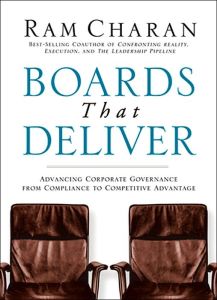Join getAbstract to access the summary!

Join getAbstract to access the summary!
Ram Charan
Boards That Deliver
Advancing Corporate Governance From Compliance to Competitive Advantage
Jossey-Bass, 2005
What's inside?
How to build a board of directors that exercises real oversight, prepares for the future and understands the present.
Recommendation
A spate of high-profile corporate meltdowns ended the days of high-flying CEOs who also ran their companies’ boards of directors. Instead, regulators, shareholders and the public now demand that corporate boards oversee CEOs and protect shareholder interests. Ram Charan lays out what your board can do to maximize its positive contributions and add value to the company. His writing is clear and to the point. This book is very helpful for board members who are trying to find their way in the post Sarbanes-Oxley world of corporate governance. Charan provides useful questionnaires to help you analyze the state of your company and its board on several crucial points. getAbstract recommends this book to board members, potential board members, and others who have an interest in modern boards and corporate governance.
Summary
About the Author
Ram Charan advises corporate directors and CEOs. He is the best-selling author or co-author of Know How, Boards at Work, What the CEO Wants You to Know and other business titles.
































Comment on this summary